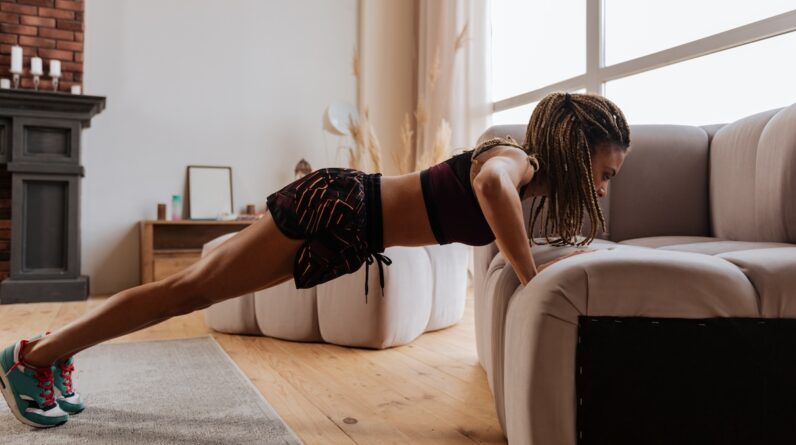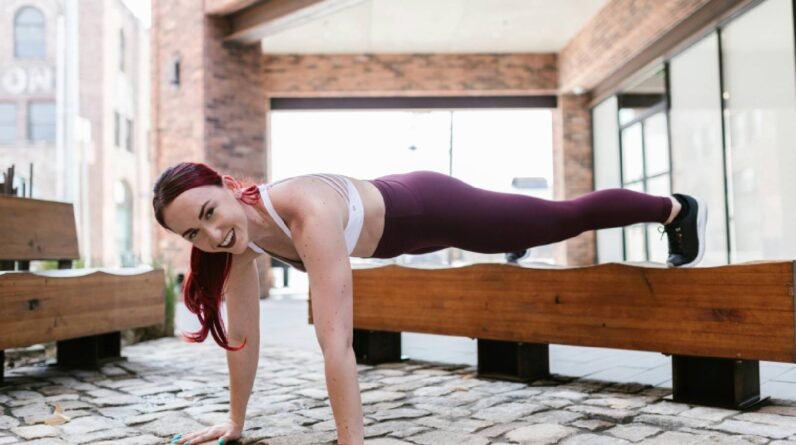
But push-ups require a lot of upper-body strength and core stability, making them hard to do—and even harder to do correctly.
Whether you’re looking to level up your push-up form or find push-up alternatives that work the exact same muscles, we’ve got tips for perfecting your technique and go-to modifications that offer the same upper-body benefits.
How to do a push-up with perfect form every time
Traditional push-ups “target almost every muscle in your upper body, no equipment required,” says Julia Caban, CPT, a certified personal trainer and coach at Performance360 in Oceanside, California.
But doing a push-up correctly is harder than it looks. Katelyn Raymond, PT, DPT, a physical therapist and director of movement at STAT Wellness in Atlanta, Georgia, suggests thinking about a push-up as a moving plank.
And just like when holding a plank, while doing a push-up, you need to keep your core engaged to keep your hips level and avoid strain in your lower back.
“Also avoid rounding your shoulders, which stresses the shoulder joint and can lead to injury,” Raymond says.
Here’s how to execute the perfect push-up:

- Start in a high plank position with your palms directly beneath your shoulders and your feet hip-width apart.
- Keeping your weight forward on your toes, draw your shoulder blades away from one another to engage your upper back and pull your belly button toward your spine to engage your core.
- Keeping your elbows at a 45-degree angle, slowly lower your torso until your chest touches the floor or mat. (If you can’t lower all the way toward the floor, go as far down as is comfortable.)
- Press into your hands and engage your core to straighten your arms and return to the starting position.
- Repeat.
Push-up muscles worked
A push-up is the ultimate upper-body workout. According to Caban and Raymond, push-ups work the following muscles:
- Biceps (front of arm)
- Triceps (back of arm)
- Pectorals (chest)
- Deltoids (shoulders)
- Upper and lower back
But you’ll also work your core—particularly your obliques (the muscles on the sides of your torso) and transverse abdominis (the deep abdominal muscles that extend from your ribs to your pelvis)—to stabilize your body as you lower and lift in the push-up position.
Push-ups also fire up lower-body muscles like your hamstrings and glutes, which help you maintain that strong plank position as you bend and straighten your arms.
The benefits of push-ups that’ll convince you to add them to your workouts
Push-ups are important because they combine trunk stability with upper-body strength and mobility, according to Raymond. In everyday life, this functional movement is similar to pushing a chair or sofa across a room or opening a door.
“Very few other movements hit such a variety of muscles without any equipment required,” Caban says.
This move also improves your joint stability, decreasing your risk of injury, whether that’s doing your sun salutations in yoga class or pulling weeds in your garden.
Spend much of your day sitting? Push-ups can help.
“Push-ups always help to open the chest area when you perform them in full range, which is great for those who have desk jobs and rounded shoulders,” Raymond says.
Modifications are a great way to build up to the traditional exercise, target the same muscles with less strain on your body, or accommodate injuries or conditions that make it difficult to execute the full push-up motion.
Okay, seriously, why are push-ups so hard?
While push-ups don’t require special equipment and are a staple of fitness classes from HIIT to Pilates, they are hard. Like, really hard.
“Push-ups require substantial trunk and upper-body strength,” Raymond says. “And a lot of muscles need to work together to perform a traditional push-up correctly.”
Caban agrees.
“When you do a push-up, you’re pushing up your entire body weight, which is not easy,” she says.
Who are push-up alternatives best for?
Modifications are a great way to build up to the traditional exercise, target the same muscles with less strain on your body, or accommodate injuries or conditions that make it difficult to execute the full push-up motion.
Push-up alternatives are ideal for pregnant people, especially those in second and third trimesters who “find a prone position to taxing on the core and pelvic floor,” Caban says.
Caban also recommends push-up alternatives for people who experience wrist pain or have issues with shoulder blade stability.
The best push-up alternatives to add to your routine
All of these push-up alternatives work the same muscles—think arms, chest, upper and lower back, and core—as the traditional exercise.
“As with everything, consistency is key. So start with a push-up variation that you can do and work from there,” Raymond says.
1. Elevated push-up
Raymond recommends this alternative because it helps you practice the long, stable plank position needed for a traditional push-up, but it’s less strenuous on your body.
“Start as high as you need to to achieve proper form—this exercise can be done using a wall, counter, table, bench, or step,” she says.

Photo: Katelyn Raymond, PT, DPT
- Place your hands on a stable surface like a weight bench and walk out to a plank position with your shoulders over wrists and your feet hip-width apart.
- Keeping your core engaged and your shoulders square, inhale as you bend your arms to a 45-degree angle and lower your chest to the bench or wall.
- Exhale as you push into your hands and straighten your arms to return to the starting position.
- Repeat.
2. Band-assisted push-up
The band supports your body so you can move through a full push-up without actually having to press your entire weight up and down.
“This is one of my favorite ways to help people feel successful in a push-up,” Raymond says.

Photo: Katelyn Raymond, PT, DPT
- Attach a long loop band to an anchor point, like a post, then wrap it around your shoulders like a backpack.
- Walk out to a plank position with your shoulders under your wrists and your feet hip-width apart.
- Bend your elbows to a 45-degree angle as you lower your chest to the ground, keeping the body in a long line.
- Press into your hands to push back up to the starting position.
- Repeat.
3. Eccentric push-up
Raymond likes this variation because it strengthens all the same muscles as a push-up.

Photo: Katelyn Raymond, PT, DPT
- Start in a high plank position with your shoulders stacked above your wrists and your feet planted hip-distance apart.
- Engage your core and slowly lower your body to the mat or ground.
- Keep your knees down as you press into your hands and lift your chest back to starting position.
- Lift your knees back up into high plank position.
- Repeat.
4. Dumbbell bench press
A dumbbell bench press is just a push-up flipped to a supine position (on your back), so it works the same upper-body muscles, according to Caban.

Photo: Julia Caban, CPT
- Lie on your back on an exercise bench, holding two dumbbells (palms facing down) on your legs for support. Make sure your feet are firmly planted on the floor. If you don’t have an exercise bench, lie on the floor with your knees bent and feet flat on the floor.
- Bring the dumbbells in line with your shoulders with your wrists facing away from your body.
- Press the dumbbells toward the ceiling as you straighten your arms out in front of you.
- Slowly bend your arms to lower the dumbbells back to your chest.
- Repeat.
5. Knee push-up
The kneeling position takes the pressure off your wrists and some load from your upper body while still strengthening your upper body and core, Caban says.

Photo: Julia Caban, CPT
- Start in a plank position with your shoulders stacked above your wrists and your feet planted hip-distance apart.
- Lower your knees to the ground, keeping your core tight and hips and shoulders in a long line.
- Press into your hands and bend your elbows wide to the side to lower your chest to the ground without hiking up or sinking down your hips.
- Push into your hands and straighten your arms to return to the starting position.
- Repeat.
6. Push-up with wrist support
Many people struggle with traditional push-ups because it puts pressure on the wrists. Using dumbbells or small parallel bars for wrist support is a great alternative for people with wrist injuries or shoulder instability, Caban says.

Photo: Julia Caban, CPT
- Grip two dumbbells or small parallel bars with your hands, wrists facing in, and knuckles to elbows in a straight line.
- Step your feet out hip distance to a plank position.
- Bend your elbows and lower your chest toward the ground, keeping your core engaged.
- Press into the dumbbells or bars and straighten your arms to finish.
- Repeat.






